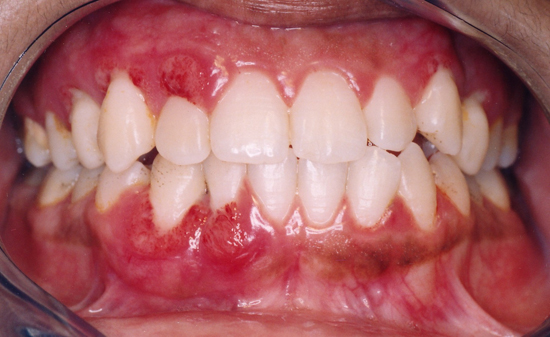1. American Academy of Periodontology. Parameter on aggressive periodontitis. J Periodontol. 2000; 71:5 Suppl. 867–869.

2. Demmer RT, Papapanou PN. Epidemiologic patterns of chronic and aggressive periodontitis. Periodontol 2000. 2010; 53:28–44.

3. Haubek D, Ennibi OK, Poulsen K, Poulsen S, Benzarti N, Kilian M. Early-onset periodontitis in Morocco is associated with the highly leukotoxic clone of Actinobacillus actinomycetemcomitans. J Dent Res. 2001; 80:1580–1583.

4. Eickholz P, Kaltschmitt J, Berbig J, Reitmeir P, Pretzl B. Tooth loss after active periodontal therapy. 1: patient-related factors for risk, prognosis, and quality of outcome. J Clin Periodontol. 2008; 35:165–174.

5. Dubrez B, Baehni P, Cimasoni G. A case of localized juvenile periodontitis: treatment and 3 years follow-up with superimposable radiographs. J Clin Periodontol. 1996; 23:557–562.

6. Sewon LA. Rapid bony healing in localized juvenile periodontitis: a case report. Scand J Dent Res. 1993; 101:371–374.

7. Novak MJ, Stamatelakys C, Adair SM. Resolution of early lesions of juvenile periodontitis with tetracycline therapy alone: long-term observations of 4 cases. J Periodontol. 1991; 62:628–633.

8. Mattout P, Moskow BS, Fourel J. Repair potential in localized juvenile periodontitis: a case in point. J Periodontol. 1990; 61:653–660.

9. Moskow BS. Healing potential in periodontal lesions: localized juvenile periodontitis. J N J Dent Assoc. 1986; 57:45–51.
10. Lindhe J, Liljenberg B. Treatment of localized juvenile periodontitis: results after 5 years. J Clin Periodontol. 1984; 11:399–410.

11. Buchmann R, Nunn ME, Van Dyke TE, Lange DE. Aggressive periodontitis: 5-year follow-up of treatment. J Periodontol. 2002; 73:675–683.
12. Kamma JJ, Baehni PC. Five-year maintenance follow-up of early-onset periodontitis patients. J Clin Periodontol. 2003; 30:562–572.

13. Aimetti M, Romano F, Guzzi N, Carnevale G. One-stage full-mouth disinfection as a therapeutic approach for generalized aggressive periodontitis. J Periodontol. 2011; 82:845–853.

14. Aimetti M, Romano F, Guzzi N, Carnevale G. Full-mouth disinfection and systemic antimicrobial therapy in generalized aggressive periodontitis: a randomized, placebo-controlled trial. J Clin Periodontol. 2012; 39:284–294.

15. Griffiths GS, Ayob R, Guerrero A, Nibali L, Suvan J, Moles DR, et al. Amoxicillin and metronidazole as an adjunctive treatment in generalized aggressive periodontitis at initial therapy or re-treatment: a randomized controlled clinical trial. J Clin Periodontol. 2011; 38:43–49.

16. Darby IB, Hodge PJ, Riggio MP, Kinane DF. Clinical and microbiological effect of scaling and root planing in smoker and non-smoker chronic and aggressive periodontitis patients. J Clin Periodontol. 2005; 32:200–206.

17. Hughes FJ, Syed M, Koshy B, Marinho V, Bostanci N, McKay IJ, et al. Prognostic factors in the treatment of generalized aggressive periodontitis: I. Clinical features and initial outcome. J Clin Periodontol. 2006; 33:663–670.

18. Yek EC, Cintan S, Topcuoglu N, Kulekci G, Issever H, Kantarci A. Efficacy of amoxicillin and metronidazole combination for the management of generalized aggressive periodontitis. J Periodontol. 2010; 81:964–974.

19. Guerrero A, Griffiths GS, Nibali L, Suvan J, Moles DR, Laurell L, et al. Adjunctive benefits of systemic amoxicillin and metronidazole in non-surgical treatment of generalized aggressive periodontitis: a randomized placebo-controlled clinical trial. J Clin Periodontol. 2005; 32:1096–1107.
20. Kaner D, Bernimoulin JP, Hopfenmuller W, Kleber BM, Friedmann A. Controlled-delivery chlorhexidine chip versus amoxicillin/metronidazole as adjunctive antimicrobial therapy for generalized aggressive periodontitis: a randomized controlled clinical trial. J Clin Periodontol. 2007; 34:880–891.
21. Mestnik MJ, Feres M, Figueiredo LC, Duarte PM, Lira EA, Faveri M. Short-term benefits of the adjunctive use of metronidazole plus amoxicillin in the microbial profile and in the clinical parameters of subjects with generalized aggressive periodontitis. J Clin Periodontol. 2010; 37:353–365.
22. Baltacioglu E, Aslan M, Sarac O, Saybak A, Yuva P. Analysis of clinical results of systemic antimicrobials combined with nonsurgical periodontal treatment for generalized aggressive periodontitis: a pilot study. J Can Dent Assoc. 2011; 77:b97.
23. Wennstrom A, Wennstrom J, Lindhe J. Healing following surgical and non-surgical treatment of juvenile periodontitis: a 5-year longitudinal study. J Clin Periodontol. 1986; 13:869–882.

24. Machtei EE, Cho MI, Dunford R, Norderyd J, Zambon JJ, Genco RJ. Clinical, microbiological, and histological factors which influence the success of regenerative periodontal therapy. J Periodontol. 1994; 65:154–161.










 PDF
PDF ePub
ePub Citation
Citation Print
Print








 XML Download
XML Download